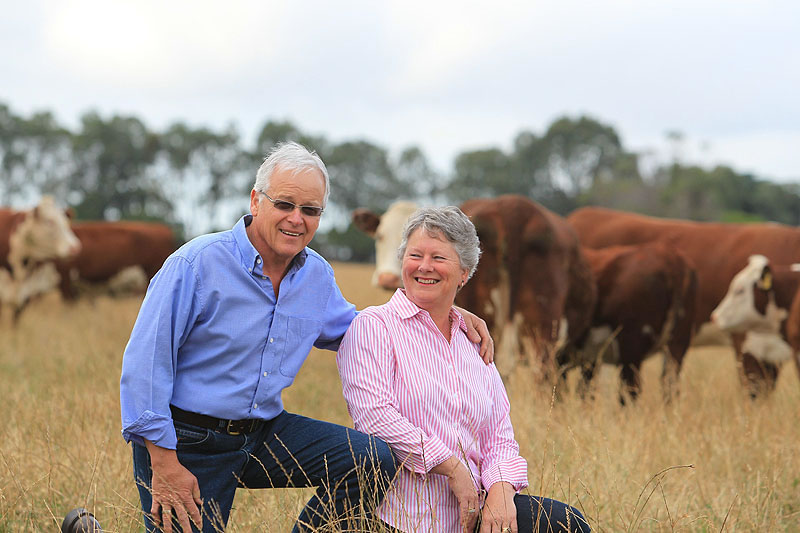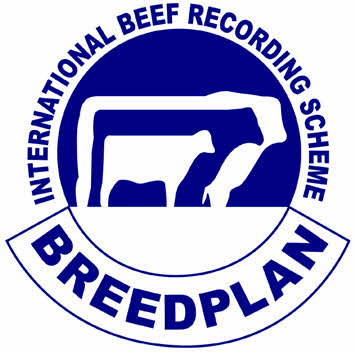Many beef producers with smaller herds wonder whether they can effectively use BREEDPLAN as a selection tool, give the small number of animals that have to work with. Bill and Minnie Kee, the owners of Warringa Herefords based as Sarsfield in East Gippsland (Victoria), have been using BREEDPLAN in their small herd for over 25 years. SBTS Technical Officer, Catriona Millen, recently caught up with Bill to discuss how he and Minnie make best use of BREEDPLAN in their own situation.

Q: Tell us a little about your herd. How many cows do you typically run?
We run approximately 30 Stud Hereford females which includes approximately 10 first calving 2 year old heifers. We try to run the herd as a single mob as much as possible.
Q: As a five star CoP herd, you record a lot of data on each animal for BREEDPLAN. Is there anything you do in terms of your management of the herd to maximise the usefulness of the data for BREEDPLAN?
As we have few numbers, we believe it is essential to record all data available to obtain the most accurate results and maximise the usefulness of the data. We also endeavour to ensure we have all our animals in the appropriate contemporary group for the collection of data. To maximise the number of animals in each group, we run animals in a single mob and have a short joining (4 weeks), which minimises age slicing. We also use several sires each year to make sure that multiple sires are represented in each group.
Q: How do you manage linkage?
In recent years we have implemented a policy to introduce superior genetics by the use of artificial insemination. We endeavour to obtain semen in outstanding young sires that have the genetic merit to obtain our breeding objectives and have been used their breeder’s herds. This gives us direct linkage to the breeder’s herd and any others that have used the same bull.
Q: Are you still able to utilise artificial breeding technologies such as AI or ET?
We have based our breeding program on the use of artificial insemination. Each year we join all females by AI on a fixed AI program. We then either reset the females with synchronisation devices to re-join them by AI on their next cycle, if they have not held to the first insemination. If we decide not to resynchronise the, the the day after they are fixed time AI’d we put a bull with the females for 4 weeks only. In either case if they are not pregnant within the 4 week period they are culled after pregnancy testing which we conduct by ultrasound about 10-14 weeks after the AI date. We do not use ET as the size of our herd renders it uneconomical and practically difficult.
Q: Do you feel you are able to successfully manage inbreeding/genetic diversity as a smaller herd? Do you use any tools to help you do so?
We believe because of our breeding program we manage inbreeding/genetic diversity successfully. In the event decide to physically join maiden heifers, after the fixed time AI insemination, we use a litter mate bull. We have not found this practise to be detrimental.
We have a detailed mating program for each heifer and cow, which we derive using all available data. Our computer software program has a mating prediction facility, which allows us to interrogate the BREEDPLAN EBV’s and Indexes of potential joinings. We also consider phenotype including frame score and eye pigment, and data from the Herefords Australia database including pedigree, parent verification, horned/poll status and genetic condition status. We also use BULLCHECK (VBBSE) information, if available, for the sires we are considering. We follow this process for each heifer and cow and as we only have approximately 30 animals it does not make the task too taxing.
Q: As a smaller herd, do you find that you can successfully use BREEDPLAN to make genetic progress?
Yes, we are strong believers in BREEDPLAN and the science upon which it is based. We believe by its use for many years our herd has made substantial genetic progress. The fact that we record all available data and DNA all our animals gives us great confidence to rely upon the veracity of the EBV’s and the genetics in our herd. Our aim is to breed all-rounder bulls that have good genetics across traits and are versatile enough to suit a range of environments, with the phenotype to match. We are proud that, after a recent change in focus of our breeding objectives, we have produced bulls that rank well above breed average for their selection indexes. Of our ten male calves born in 2019, 50% are in the Top 20% or higher for all four Hereford selection indexes, with one in the Top 5%. Being a smaller herd doesn’t stop is from producing quality genetics.
Q: Hereford has had Single-Step BREEDPLAN now for several years. As a smaller herd, have you found genomics to be beneficial and how do you utilise it in your herd?
Yes, we have found genomics to be of substantial benefit in our herd. All of our cattle have been DNA genotyped using a 50K SNP panel. We take a TSU DNA sample from every calf on the day it is born. DNA testing allows us to guarantee the accuracy of our pedigrees, allows us to test every animal for all known adverse genetic conditions, to test for homozygous and heterozygous polledness and at the same time test all our animals for Pestivirus. Genomic information is also included in our her’d Single-Step BREEDPLAN EBV’s. For a smaller herd like ourselves, genomics has been extremely beneficial. The increase in accuracy is particularly noticeable for those in smaller (including single animal) contemporary groups.
Q: What have been the challenges of being a smaller herd?
We believe the main challenge is the lack of numbers, which makes it harder, but not unmanageable, to maintain adequate contemporary group size when recording data.
Q: Do you think there are any advantages of being a smaller herd in BREEDPLAN?
We believe there are many advantages:
- It has allowed us the opportunity to use AI to introduce the best available genetics into our herd and to manage our herd tightly, without compromise and add pressure, to set breeding objectives to obtain substantial genetic gain in a shorter period; and
- It has made the utilisation of the above-mentioned technologies affordable.
Q: What would you say to breeders who say their herd is too small to use BREEDPLAN effectively?
You are never too small. It is important to use all the available knowledge, tools and technologies to achieve your breeding objectives. Our view is, however, that it must be done properly to ensure you obtain the best 4results; that is, all the available data should be recorded and submitted, and genomics used (where available), to obtain the best results from BREEDPLAN. There are no rewards for poor or no data and there is no substitute for quality data!










